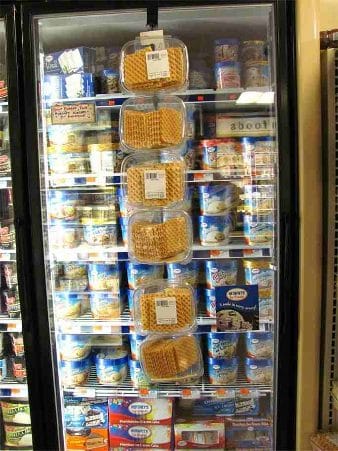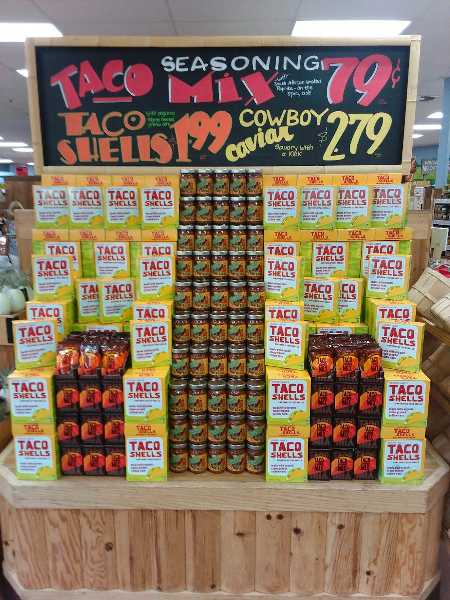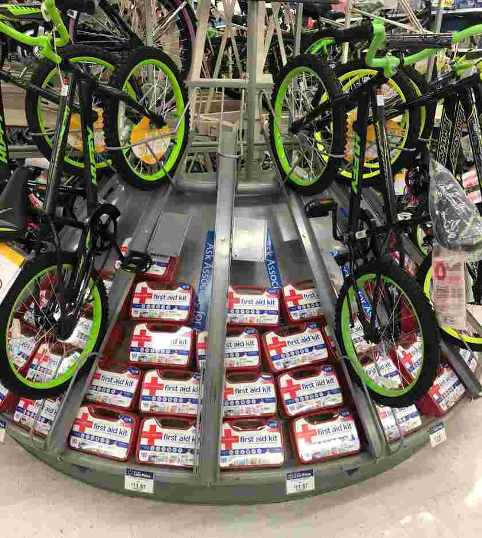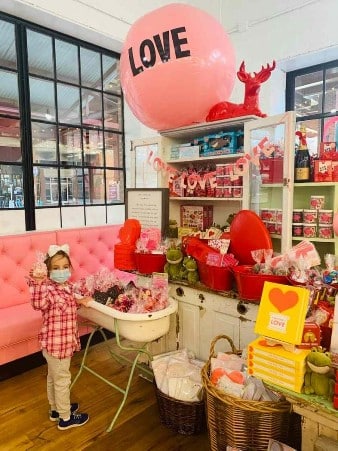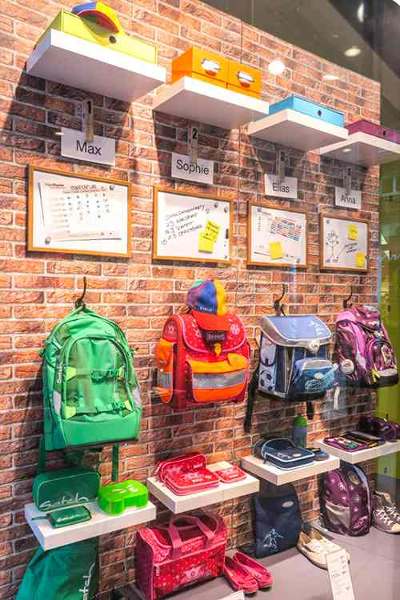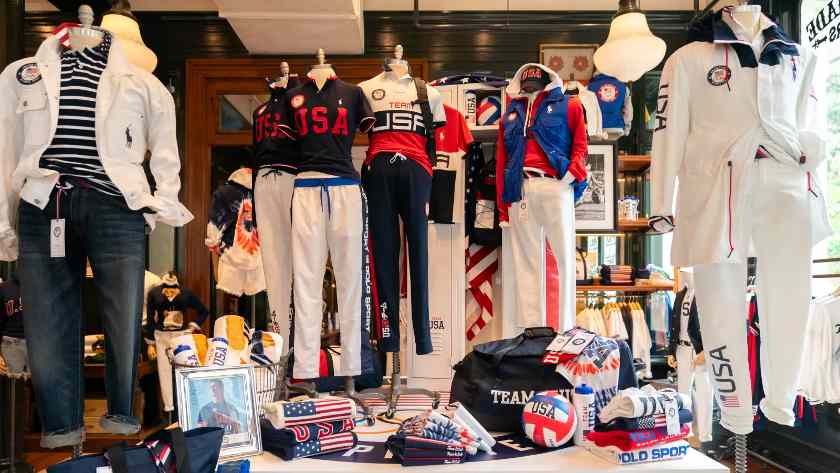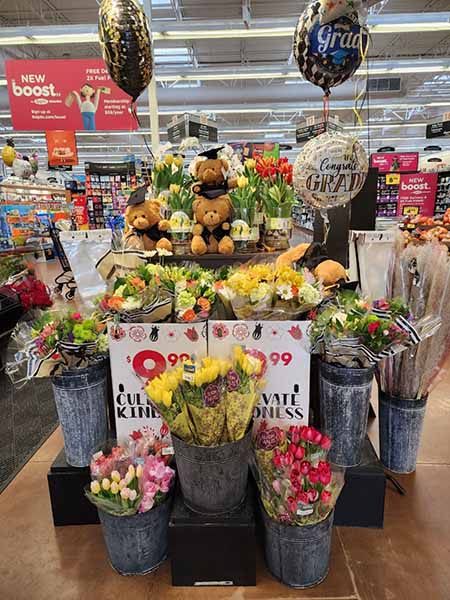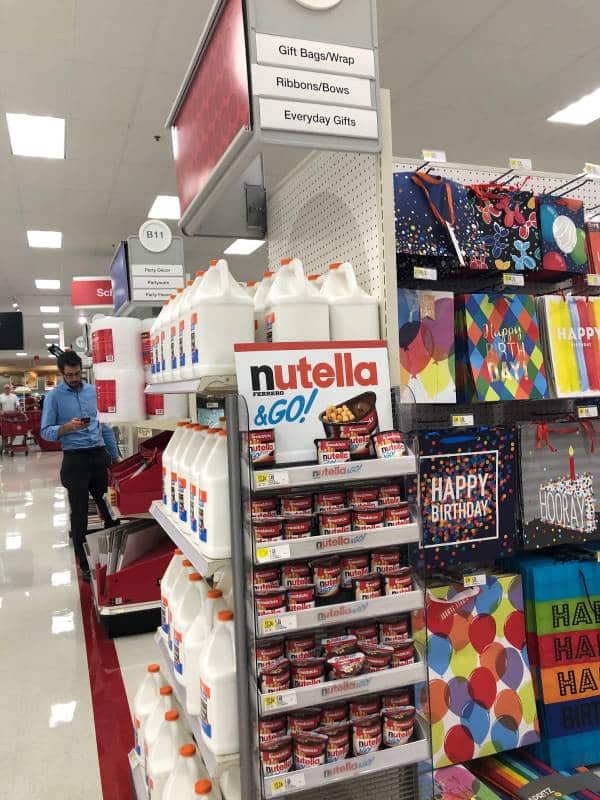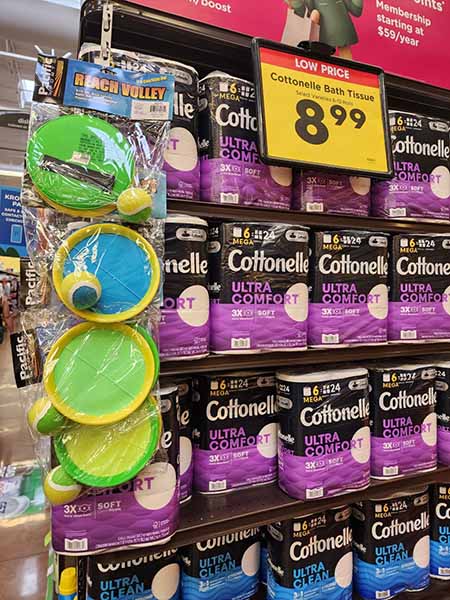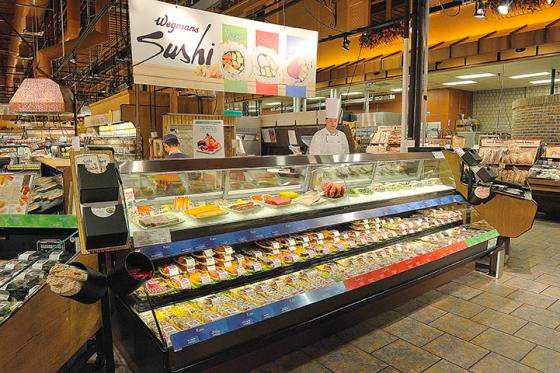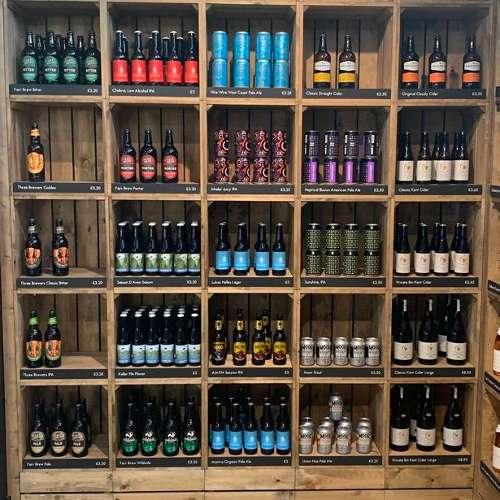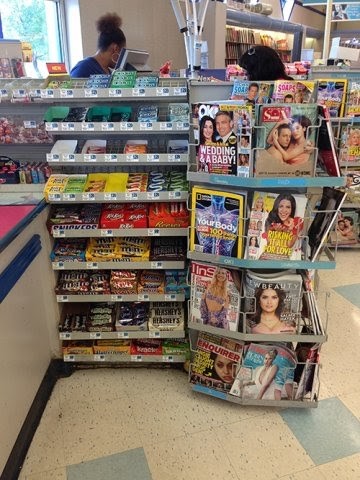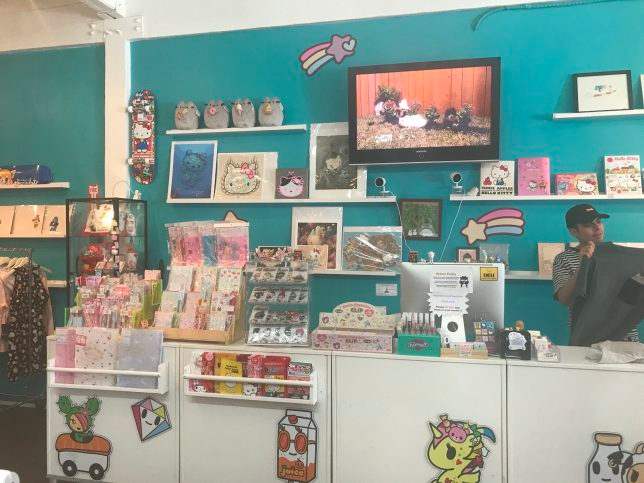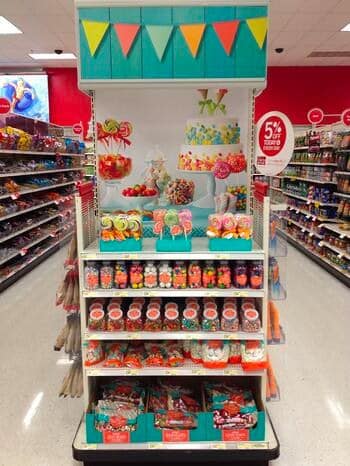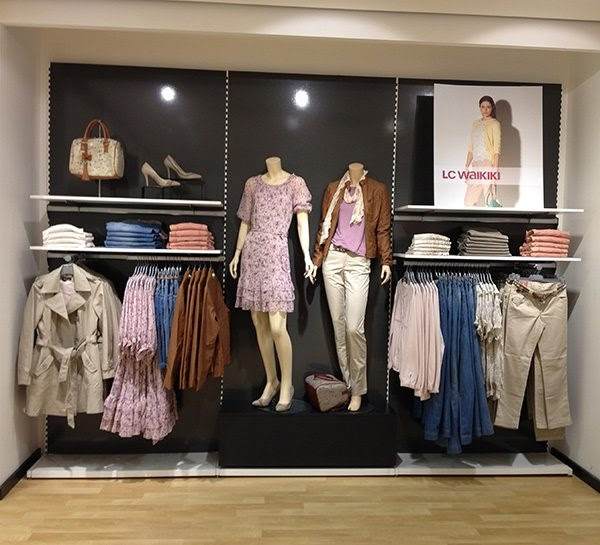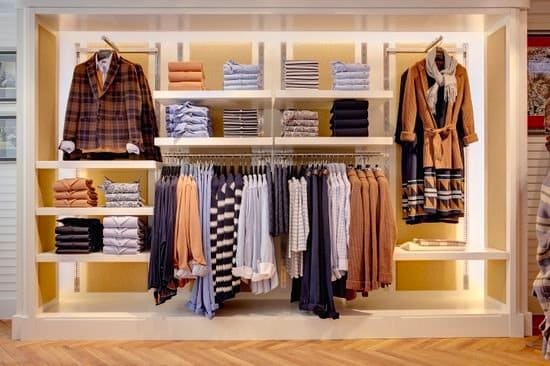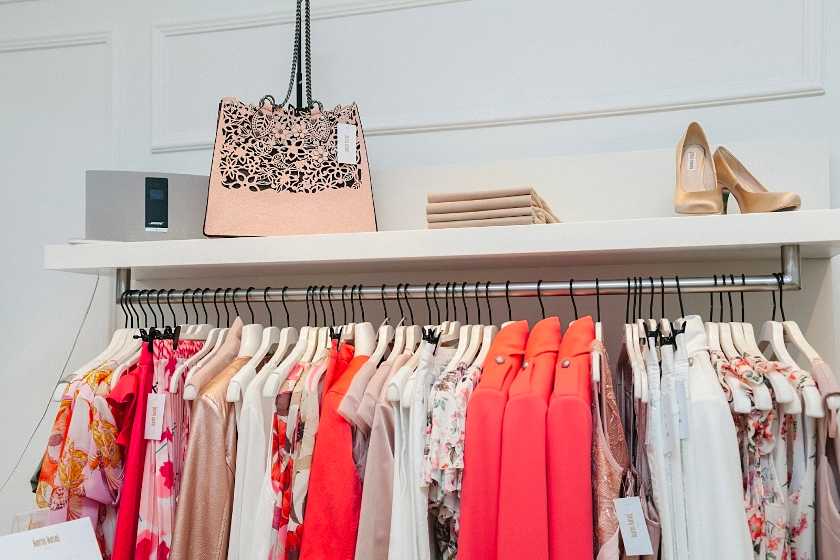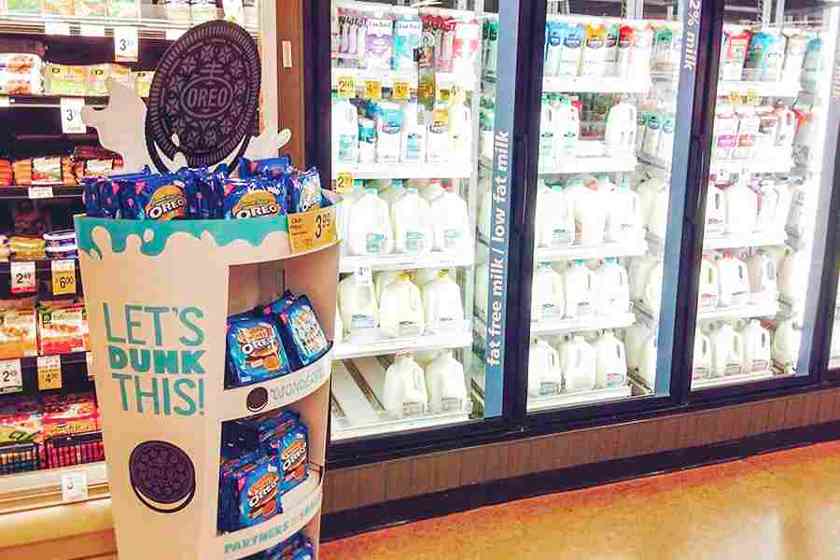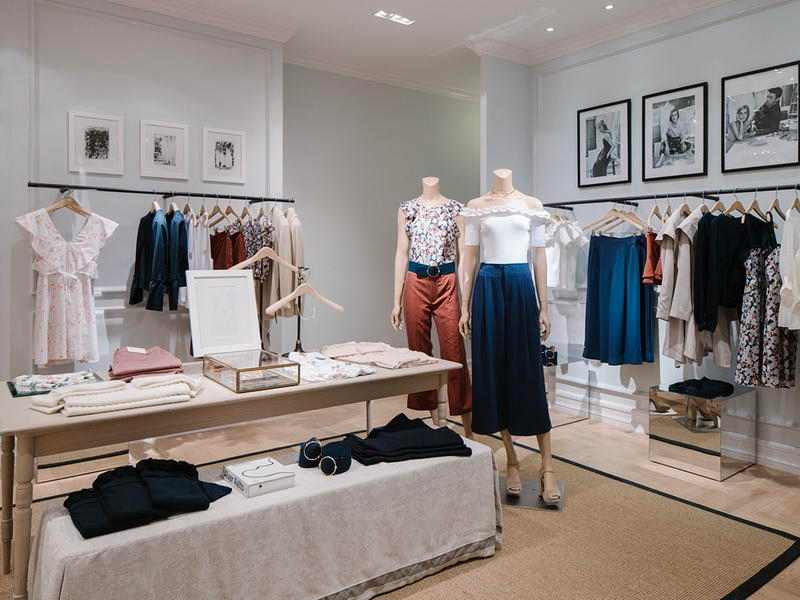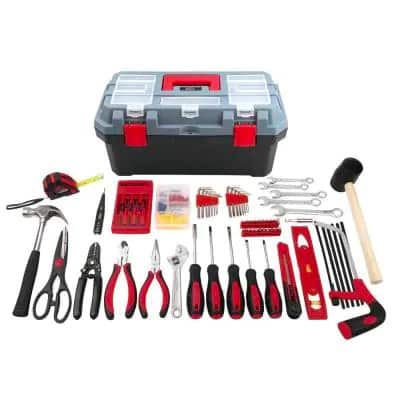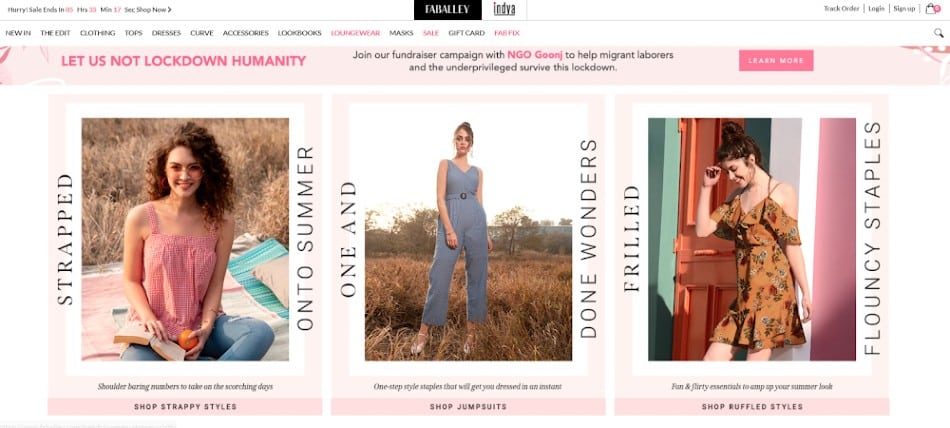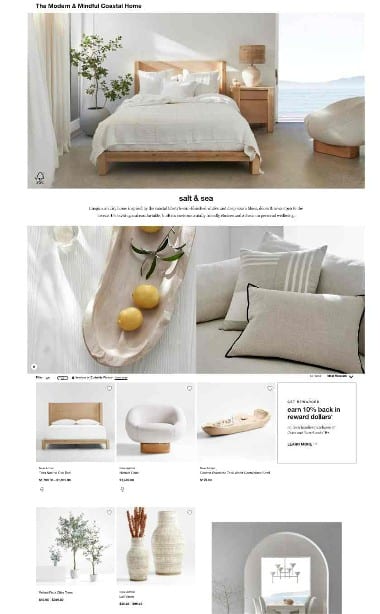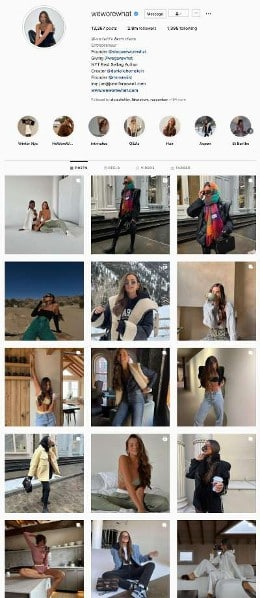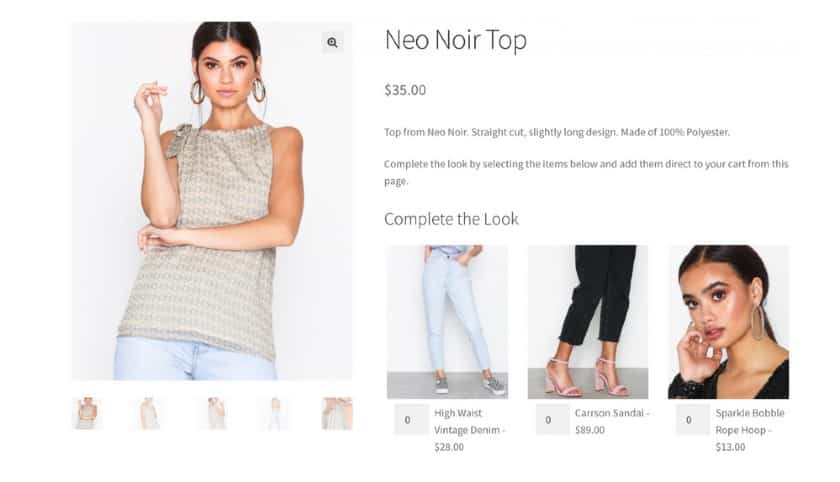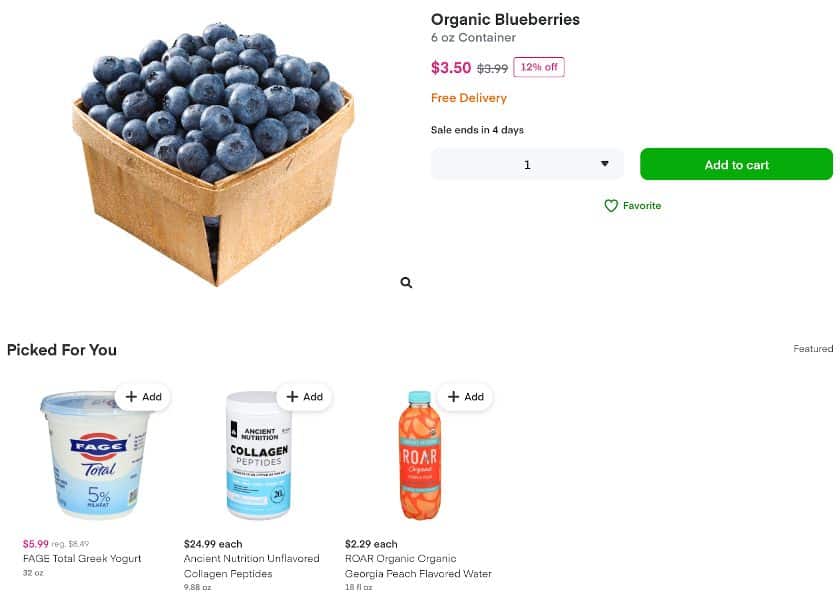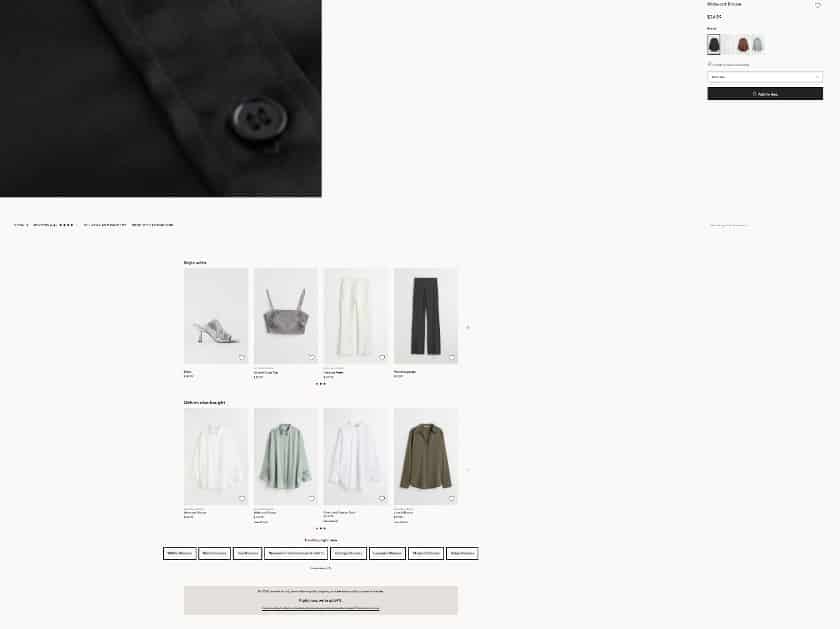Cross merchandising is the practice of displaying items from different product categories together to incentivize multi-item purchases. It works by reminding customers of a need, sparking ideas, and streamlining their shopping process. At the same time, cross merchandising benefits business owners by driving more sales.
In this article, we’ll explore how cross merchandising is used and discuss 13 cross merchandising strategies along with real-life examples.
Why Use Cross Merchandising?
Cross merchandising enhances profitability and the customer experience. It’s easy to implement for in-store or online businesses of any size and has been shown to increase sales by 20% on average. Cross merchandising benefits include:
- Driving sales growth
- Triggering impulse purchases
- Increasing average transaction value
- Advertising new products
- Aiding in inventory management
- Moving products with slow turnover rates
- Creating a customer-friendly store layout
- Streamlining the shopping process
- Reducing the likelihood of customers forgetting items
- Providing inspiration and fresh ideas for new purchases
13 Cross Merchandising Techniques for Retailers
Here are in-store and online cross merchandising strategies you can implement to start reaping the rewards.
1. Drive Impulse Sales With Complementary Items
The most common type of cross merchandising in retail is placing items typically used or consumed together in the same area to promote a joint purchase. This strategy is used across all industries and can help drive impulse buys.
For example, some grocery stores will display packets of cookie dough along with milk, bottles of wine with gourmet cheeses, or waffle cones with ice cream. Even though these product pairs are in different categories, they are often purchased and used together, which leads to impulse buys.
Placing complementary items in the same display will also streamline the shopping experience for your customers, making it easier to find items that logically go together without having to search the whole store.
A popular complementary items strategy involves placing a primary item with a smaller, less expensive add-on item. This technique is also known as secondary product placement and will make customers more likely to make add-on purchases.
2. Spark Ideas With Thematic Cross Merchandising
Thematic cross merchandising involves placing items together based on a theme, such as an upcoming holiday or the start of the school year. Thematic displays often bring together products from various departments to provide a solution or spark an idea.
For example, at my boutique, we would always highlight Valentine’s Day by creating a table and rack display featuring our red, sexy, and love-themed pieces. We would also pull applicable items from everywhere in the store—like jewelry and cards—plus new Valentine’s add-ons, like stuffed bears and chocolate hearts. This made it easy for shoppers to throw a date outfit or gift together without having to search the whole store or start their ideas from scratch.
Thematic merchandising will often feature theme-specific items that are only on the sales floor for a limited time, like the stuffed bears and chocolate hearts mentioned above. Layer these items with your regular products to help move through seasonal merchandise and spark ideas on how “normal” products can work for the season in question.
Interested in learning more about merchandising strategies to help drive your sales? Check out our article on visual merchandising strategies for a comprehensive guide.
3. Make Products Stand Out With Contrasting Merchandise
Placing items together that are unrelated or contrasting is another cross merchandising strategy. Retailers use this strategy to catch shoppers’ attention and make them pause to really look at the products on display.
For example, in the spring, grocery and box retailers will sometimes display Peeps marshmallows all over their stores so shoppers know they are available. Similarly, around Halloween, some retailers will display spooky decor or fun-size candy in unexpected places to remind shoppers of the upcoming holiday.
Contrasting product merchandising is great when you want to highlight a product that doesn’t move well by placing it with one of your bestsellers. It can also be used to draw awareness to seasonal or limited-time items.
4. Boost Margins With Substitute Options
The use of substitute products is a type of cross merchandising strategy that places alternative solutions next to a more traditional product. The substitute product typically saves the shopper time by allowing them to see all their options in one place or inspires a more expensive product purchase—creating a higher margin for retailers.
This strategy is especially popular among retailers that carry their own line of products, as they can place their alternative next to the traditional brand name item. Additionally, this tactic is often used to showcase the more expensive version of the same product and incentivize customers to try something new or treat themselves.
Did you know?
Customers are more likely to buy items that are on eye level, so place your most expensive item substitute on eye-level shelves to incentivize the purchase of products with better margins.
For example, many grocery stores sell containers of pre-diced onions near the regular onion displays. Or, retailers place their brand of white T-shirts next to a fan favorite such as Hanes.
5. Incentivize Add-on Purchases With Impulse Items
Impulse item cross merchandising is when you place impulse items—products often purchased without forethought—in areas of your store where shoppers are most likely to notice them. Impulse items are typically small, low-cost items that customers can easily add to their purchase (like candy, costume jewelry, cards, or snacks). Places where impulse buys are likely to occur include the area around the register, store entrances, end-cap displays, and sale or bargain areas.
The most common example of impulse item cross merchandising is the grocery or convenience store checkout aisle. Here, you’ll usually find an assortment of candy, magazines, lip balms, mints, lighters, hair ties, and other low-cost odds and ends. These items have nothing in common other than being popular pieces that shoppers might purchase on a whim.
6. Use Bestsellers to Draw Customers’ Attention
Retailers can also cross merchandise bestselling products with substitute or complementary products to draw customers’ attention and promote the sale of the surrounding items. By giving your bestsellers a standalone display or feature location alongside unrelated products, people will be drawn in by the product they recognize and more inclined to shop the entire section.
For example, at my store, we created complete outfits on our face-out racks that included one “staple piece,” or an item we know customers loved. We then added another “statement item,” or a new and bolder article, to complete the look. The staple piece worked to engage shoppers with something they knew, and by pairing it with another statement item, the second item was able to gain visibility and engagement as well.

Bestsellers are displayed near other product options to help them gain visibility and promote product exploration.
(Source: Array Marketing)
7. Inspire Customers With Complementary Rack Arrangements
Another cross merchandising technique is arranging your racks with pieces that can go together to create a complete look. This will spark inspiration in your shoppers. It is also a space-effective way to logically layer unrelated products and drive sales.
I suggest starting with a key piece—either something bright, printed, or a bestseller—and layering out with matching items from there. The key product will draw the customer’s attention, and the surrounding pieces will be logical add-ons to their look.
Additionally, merchandising each rack with a specific color family will make it easy for shoppers to find compatible pieces and incentivize them to purchase a matching product to go with their initial item.
For example, at my boutique, we would arrange our racks so that whenever we had a skirt or outerwear piece (some of our bestsellers), the surrounding items would be shirts or blouses that could easily match. This turned the interest piece into an outfit. Customers loved that when they grabbed a jacket off the rack, they didn’t have to search high and low for a matching shirt.
In other cases, customers who only planned on purchasing one item would be more inclined to add a matching piece to their purchase. Who can blame them when the perfect blouse was hanging right there?
8. Draw Attention to Underperforming Products
Retailers can increase sales by placing slow-moving products in different store areas where they might gain more attention. They can also be displayed where shoppers are more likely to realize a need the product will fulfill.
For example, Buehler’s Fresh Foods, a grocery store in the US, sold cherry pitters for years. However, they were not selling. Then, Buehler’s decided to place the cherry pitters in the produce section alongside bags of fresh cherries, and they sold out of cherry pitters in all 15 locations.
This strategy involves a lot of trial and error, so monitor how your underperforming products are doing as you move them to different places around the store. Every product has a customer—you just have to find a way to communicate with that customer through merchandising.
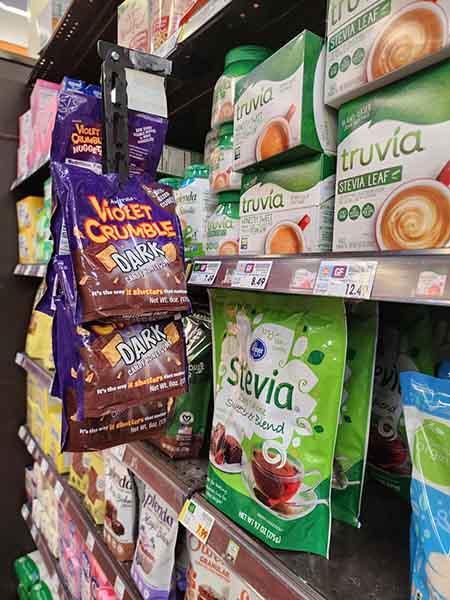
This bag of foreign candy with unfamiliar packaging is unlikely to attract shoppers in a whole aisle of tried-and-true brands. To boost visibility, the seller chose to display it in an area where it can get more attention. (Source: Fit Small Business)
9. Utilize Product Demos & Samples to Show Use Cases
Product demonstrations and samples are when retailers create a display in which sales associates show how products are used or give out samples for customers to try.
You can use cross merchandising in product demonstrations and samples by combining products from multiple departments to show how they can work together, inspiring customers to buy all the components to recreate the demos and samples at home.
For example, a home improvements store might demonstrate how you can make a birdhouse with your kids using several tools, a few hardware bits, some wood, and a paint kit. Or, a grocer might sample an easy dinner idea that combines just three ingredients from throughout the store.
Product demonstrations are particularly effective for selling food, drinks, kitchen gadgets, tools, etc., and are a great way to inspire customers to use products in ways they may not have thought of before. Samples and demos also offer an excellent opportunity to show off slow-selling or new products that customers might not be aware of.
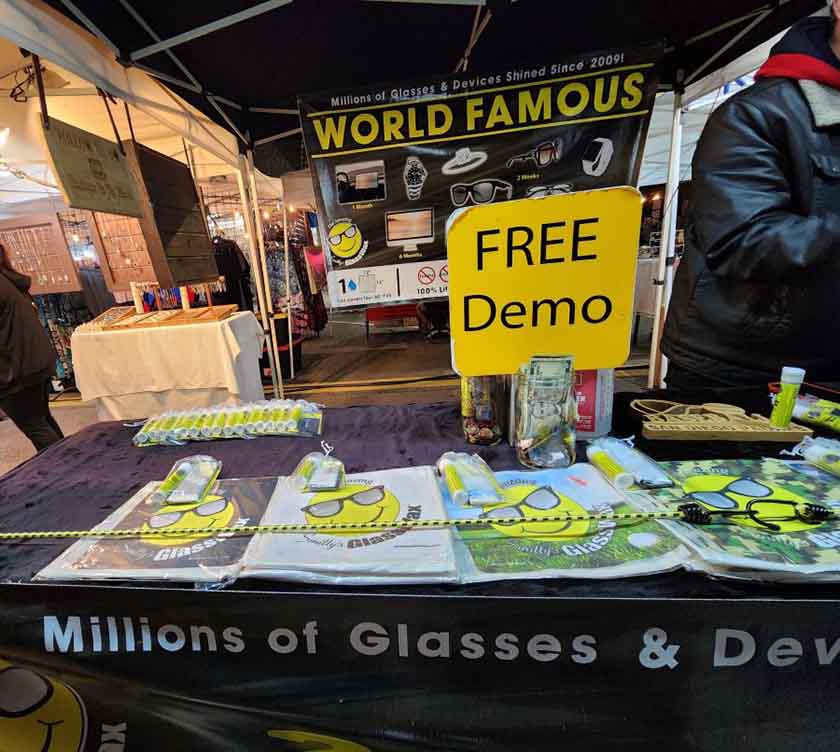
This market seller offers to clean shoppers’ glasses to demonstrate how his eyeglass cleaner works well with his branded microfiber cloths. (Source: Fit Small Business)
When setting up a demonstration, ensure that all the products in use are placed around the display. This makes it easy for customers to add them to their cart on the spot. Additionally, be sure to provide your sales associates with all the product knowledge they may need to answer shoppers’ questions.
10. Make Product Connection Clear
When cross merchandising in retail, you want to be sure that even though the products being displayed together are not departmentally related, their connection is logical and clear to shoppers.
One of the great pitfalls of cross merchandising is when your merchandise placement is nonsensical to customers, as this will not only decrease your sales potential but may dampen your customers’ experience and perception of your business.
For example, say you’re shopping at an art supply store, and you find bleach displayed alongside black sweatshirts. Without making it clear that you can use the bleach to create fun, tie-dye designs on black clothing, this combination will not make sense to customers. This will not only give shoppers the impression that your store has an illogical or sloppy layout but will cause people to buy neither the clothing nor the bleach because there is no purchasing incentive.
To avoid this issue, use signage or demonstrations that make the product connection clear. You want to be sure that when you are cross merchandising, you are considering if the products would make sense to you as a customer. If the answer is no, you need to add display elements that will help create the connection.
11. Try Bundling Strategies to Help Upsell
Effective both in-store and online, bundling is when a retailer packages several products together to be sold as a group—for example, a bath kit that includes bubble bath, a towel, loofah, and lotion. Bundling is a great strategy in cross merchandising, as you can bundle items from various departments in a cohesive way that will encourage customers to purchase multiple items in a single transaction.
Going back to the bath kit example, say a customer was visiting your store just to pick up some bubble bath, but they see the bath kit option on display and decide to purchase the bundle. This gets them to walk away with four items when they only intended to buy one. Upsells like these are great ways to drive your sales.
Online, simply consider what products are typically used together (like batteries and a flashlight), and make those items available for both individual sale and as a bundle on your product pages. You can also make “frequently purchased together” suggestions, with the estimated price of all the items bundled together.
Bundling is an especially popular strategy around holidays, as bundled packages are great for easy gift-giving. Another way to incentivize bundle purchases is to offer the bundle at a discount, where purchasing the items individually would cost more than buying them in the set. This will give customers the sense that they got a great deal while driving up your average ticket value.
12. Use Lifestyle Examples to Demonstrate Utility
A popular online cross merchandising technique is to use lifestyle examples to show how products can be used in real life. This can be accomplished through:
- Photos: Add lifestyle photos to your website to illustrate your products in real life.
- Blog posts: Write blog posts that talk about your products and how they can be used day-to-day.
- Influencer demonstrations: Reach out to influencers, and have them use your products in a post to show how a real person puts your merchandise to use.
- Product catalogs: Create a product catalog that provides information about product features and uses.
Want to learn more about incorporating a blog into your online presence? Check out our article on starting an Instagram blog.
Retailers will often feature their lifestyle content on their homepage, so as soon as customers enter their online storefront, they are inspired and can see a real-life example of how they might use your products.
For cross merchandising, your lifestyle content will work similarly to an in-store demonstration, when you’re able to combine several products to show how they can be used together. For example, a website might feature a group of models clad in the brand’s clothing and handbags while exploring a city. Another site might show someone using the brand’s pasta maker in their home kitchen, along with its new dinnerware and flatware lines.
13. Make Add-on Suggestions
Add-on suggestions are when online retailers display complementary items on another piece’s product page so they can easily be added to shoppers’ carts. This strategy can be used to show customers all their options (like alternate colors or models), spark inspiration, and incentivize add-on purchases.
A popular example of this strategy is the “Complete the Look” suggestion. This is when clothing retailers will show the pants, jewelry, and bag that make the blouse you clicked on into a complete outfit.
Add-on suggestions are also a great cross-selling strategy because they make it tempting and easy for customers to add more items to their purchases.
Another great opportunity for making product suggestions comes when customers enter their shopping carts. If you are able to monitor what people have already selected and are planning on buying, you can suggest other products that complement or are similar to the items in their carts. This is a great opportunity to cross merchandise products that customers may have missed, and it places them conveniently so customers don’t have to search your whole website.
For example, if a customer has a few summer blouses in her cart, you can show a pop-up during checkout advertising your sandal special (another summer item from a different department).
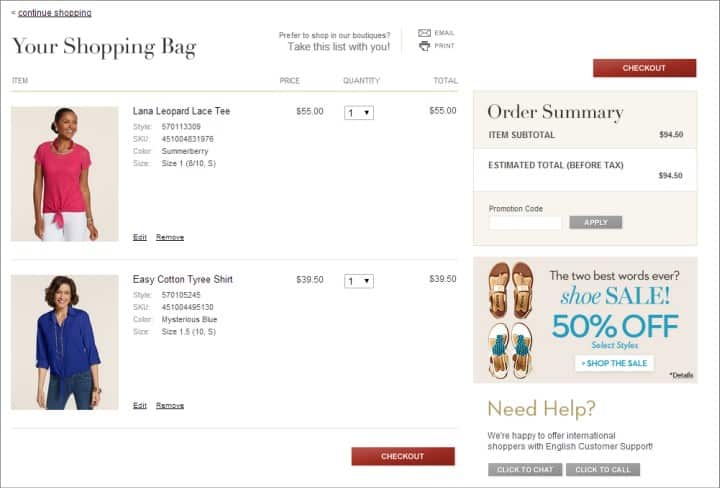
An in-cart pop-up for sandals directs this summer shopper to more fun pieces to complement her blouses.
(Source: Nielsen Norman Group)
Tracking & Improving Your Cross Merchandising’s Effectiveness
Measuring the effectiveness of your cross merchandising comes down to sales and whether your strategies are driving them. Keep in mind, however, that cross merchandising is a game of trial and error. You will likely have to try many strategies and continue evolving them to keep your cross merchandising at its best.
Use the following strategies for driving and tracking your cross merchandising success:
The best way to understand how well your cross merchandising is working is by keeping track of your sales data. You’ll want to analyze how cross merchandised products are selling and look for shopping trends that you can emulate in your cross merchandising.
For example, say you have determined that the majority of shoppers who are buying pasta sauce are also buying pasta. This insight would lead you to cross merchandise these products. Or, say you place watering hoses in the seeds aisle at your home goods store, but they’re not selling well. This might lead you to position the watering hoses in the gardening tools section instead.
Some retailers choose to do this through observational data, especially in smaller storefronts. For larger retailers or those wanting an automated system, we recommend using an integrated point-of-sale (POS) system like Lightspeed. Lightspeed is a cloud-based system that monitors sales and offers built-in reports with data on inventory, employees, and more.
Observational Data: Insights on sales or other retail metrics like customer experience or employee sentiments based on the on-the-ground findings of you or a salesperson.
Another way you can get insight into successful cross merchandising techniques is by researching what methods your competitors are using. These can be other small businesses, but you can also look to your industry’s leaders.
Industry leaders typically have corporate merchandising departments that are constantly researching best practices and monitoring their own success to inform every merchandising decision. Take advantage of their insights by visiting their stores and taking cross merchandising inspiration to drive your own sales.
For example, at my store, we sold bohemian-inspired casual clothing similar to Urban Outfitters and Free People. Our merchandising team would constantly visit Free People and Urban Outfitters to find inspiration and get insights into how these leaders were styling and setting up their stores.
Units per ticket, or the average number of units sold per transaction, is a great data point to help you understand how your overall cross merchandising is performing. Many businesses will track this number on a weekly or even daily basis.
If this number is going up, the number of products being sold in every transaction is increasing, and your cross merchandising initiative is performing well. If this number is going down, the number of units being sold per transaction is decreasing, and your cross merchandising needs some reevaluation. UPT will not offer insights into specific products, but does give an overall picture of the efficacy of your cross merchandising techniques.
Read about more retail metrics to drive sales in your store.
Cross Merchandising Examples by Industry
Any retailer can use cross merchandising to increase sales, but it will look different depending on the type of store. You’ll want to consider your customers’ needs and shopping behaviors when devising a cross merchandising plan. These factors will look different depending on the industry, so cross merchandising strategies should also vary from retailer to retailer.
Cross merchandising strategies are an important part of planning your store layout. Check out our article for more information, or download our step-by-step guide to plan your store layout.
When it comes to who is doing your merchandising, this will depend on your size. Larger businesses typically have central operations departments dedicated to testing and rolling out merchandising strategies. For small retailers, however, merchandising strategies and execution are generally the responsibility of the store owner or manager.
Cross merchandising is used in almost every type of retail store, including:
Since grocery shoppers often have a set shopping list, grocers will use cross merchandising primarily to facilitate an easy shopping experience. For example, placing chips with jalapeno peppers, avocados, and guacamole seasoning packets will make it easy for shoppers to get everything they need to make guacamole.
Following this “recipe format” is a popular technique to expedite and simplify the customer shopping experience. Think pasta sauce in the same aisle as pasta, and flour with the chocolate chips. There is also potential to spark meal inspiration here. Simply placing an array of ingredients together with some indication of how they work for a recipe is a great way to get grocery shoppers to try new products and increase your sales.
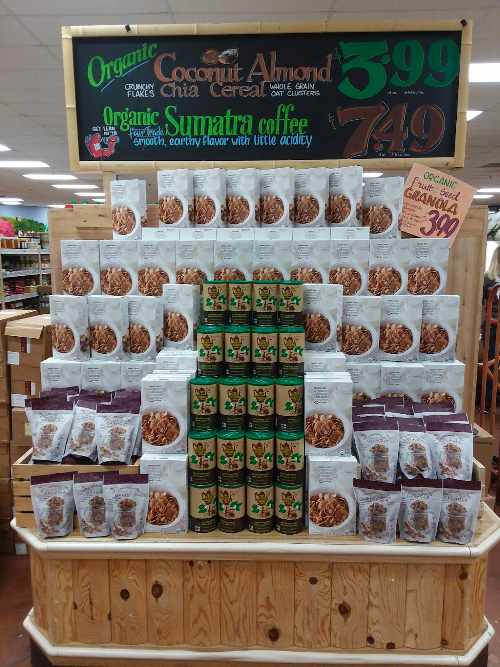
This grocer cross merchandised several different breakfast items, making it easy for customers to grab their morning essentials or to inspire a new meal.
(Source: Pinterest)
Box stores typically have a wide array of merchandise, and shoppers tend to have set preferences as well as browsing tendencies. In this case, cross merchandising is used to facilitate an easy shopping experience. This includes installing seasonal or thematic product displays so timely products are at the forefront, as well as putting complementary items close together so shoppers don’t have to search the entire store.
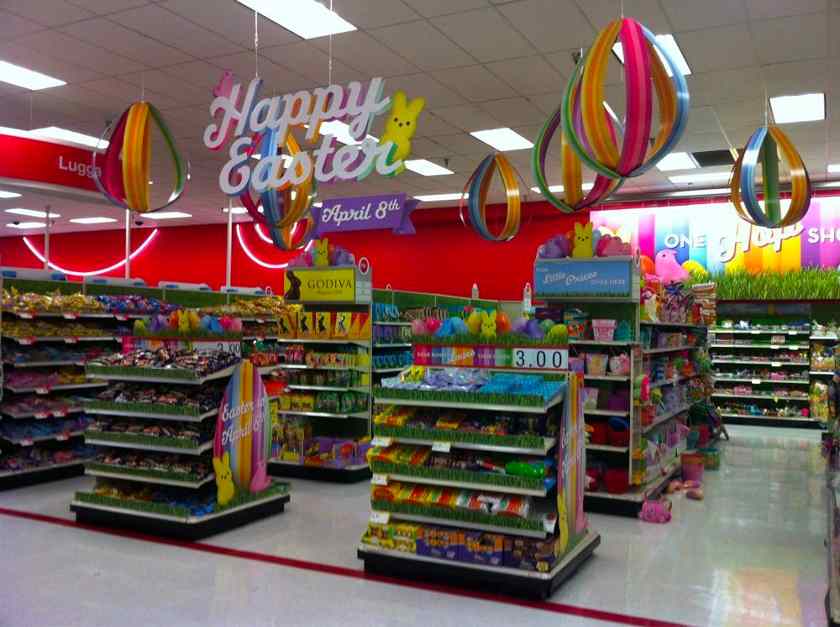
Big box stores aim to make the most relevant items easy to find—holiday displays are a great way to keep the timeliest products at the forefront. (Source: Pinterest)
When entering a convenience store, customers are generally coming for a specific product, so these retailers focus on cross merchandising to drive impulse buys. For example, displaying snacks on the side of a beverage refrigerator makes grabbing a bag of chips to go with your soda almost irresistible.
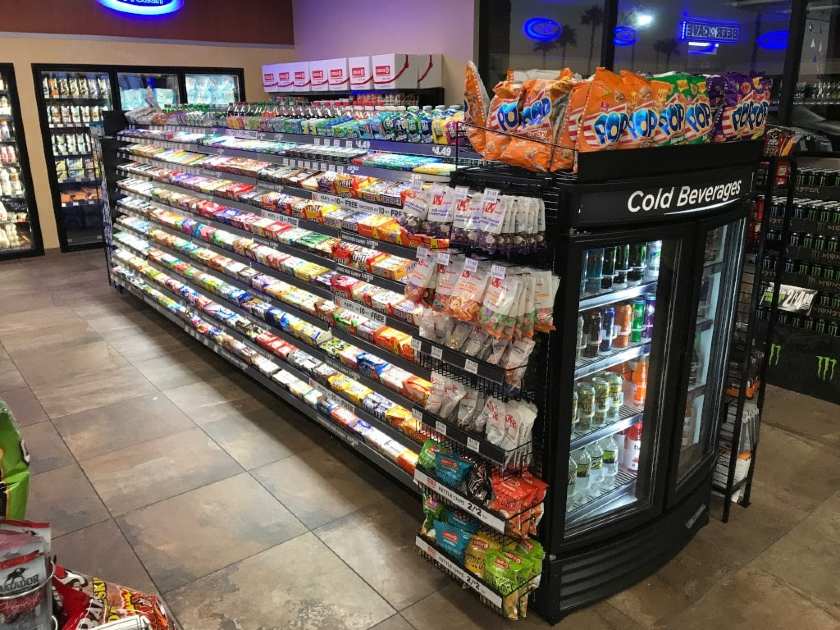
Snacks are hung on the side of a beverage refrigerator, making grabbing a snack and drink quick and easy.
(Source: Creative Display Works Inc.)
Shopping at boutiques is often a creative and exploratory experience for customers. In many cases, they do not have set desires and are there looking for inspiration. For this reason, boutique retailers use cross merchandising to spark ideas through the use of displays, complementary product placement, and smart rack arrangements.
At my store, there were countless shoppers who would come in eager to buy, but doubted their ability to put an outfit together themselves. Though sales associates were there to help, these customers would often end up buying an entire look off of a mannequin display out of convenience and assurance that the pieces would work well together.
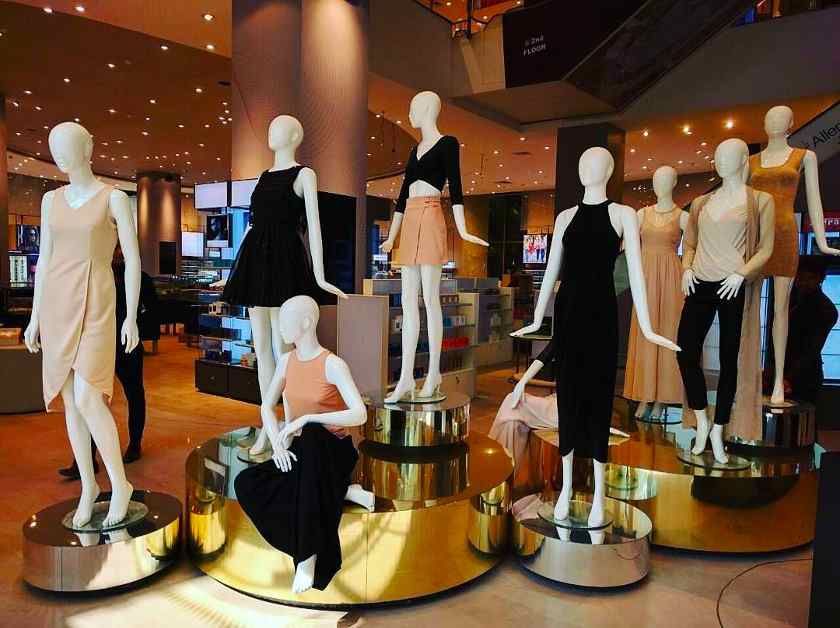
These mannequins offer fantastic sources of inspiration for boutique shoppers and show them how multiple items can work in tandem. (Source: Business Object Tips)
Gift shops, particularly those in tourist destinations, are typically used by customers for browsing and (you guessed it) gift shopping. For this type of retailer, cross merchandising is used to create thematic displays and sell combinations of gift items. For example, a gift store might bundle a seaside scented candle with a decorative shell to sell as a combo gift.

Simone LeBlanc, an online gift retailer, has pre-bundled gift boxes to make gift giving easy for customers and promote multi-item purchases.
(Source: Simone LeBlanc)
Office supply stores sell a wide variety of products that fall under an umbrella category. Shoppers tend to use these kinds of shops to get specific items while also browsing. Office supply stores use cross merchandising to introduce customers to new brands and innovative supplies by displaying them alongside staple products.
For example, say you’re shopping for ballpoint pens. When you find the writing utensils aisle, there are bright displays for new, erasable pens and special notebook paper that ink doesn’t bleed through. You would have never seen these products if they hadn’t been right next to the Bic pens that you usually use, and they create a tempting alternative.
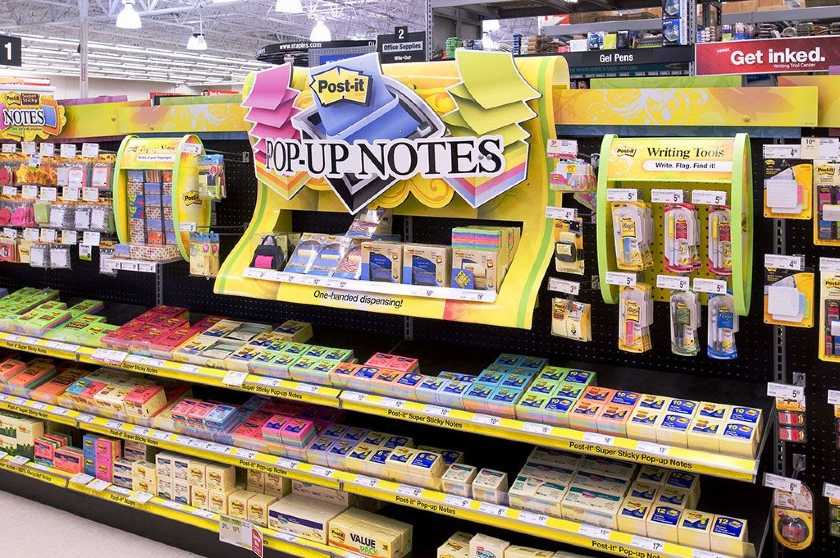
New products from Post-it are displayed above their signature sticky notes. (Source: RockTennDisplays)
Cross Merchandising Frequently Asked Questions (FAQs)
A retail store might use cross merchandising by positioning complementary products together—like pasta with tomato sauce, apples with caramel dip, or a dress with matching shoes.
Similarly, some stores will feature seasonal displays that cross merchandise a number of items that relate to the theme. For example, a seller might have a display of chocolates, flowers, and teddy bears during Valentine’s day, or a selection of pie crusts, canned pumpkin, and meat thermometers around Thanksgiving.
One way that grocery stores use cross merchandising is by placing a selection of salad dressings and croutons in the produce department. Another example of cross merchandising in grocery stores is the placement of cooking utensils near items they could be used on. Many stores will position spatulas and grill brushes next to bags of charcoal, or vegetable peelers near the carrots and potatoes.
Cross merchandising is a great way to increase sales while giving your customers a positive experience. It has been shown to significantly increase profits and average transaction value, and can help bring visibility to slow-moving products. Shoppers benefit from cross merchandising by helping them explore new product categories and inspiring creative ideas for their purchases.
Bottom Line
Cross merchandising in retail is the practice of displaying products from different categories together to increase sales. This product placement strategy works by reminding customers of a need, offering a convenient solution, or sparking an idea. Cross merchandising typically requires some trial and error, and retailers need to pay close attention to their sales data and customer shopping patterns to cross merchandise effectively.
Merchandising will be a major part of starting your retail business, and cross merchandising is only one aspect of your entire merchandising strategy. Read our article on merchandising definitions and strategies to learn more about the other elements of merchandising, including product pricing and store layout, and how to implement them.
